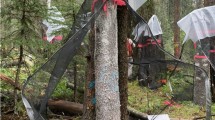Abstract
A new strain of the fungusBeauveria bassiana Nov. EO-1 (ATCC 74037), which produces a red pigment in solid and liquid culture, has been isolated from an infected whitefly. The red pigment was extracted and has been identified by mass spectrometry as oosporein, a potent dibenzoquinone mycotoxin.
In order to assess the potential of this entomogenous fungi for microbial control purposes, a mycelium bead formulation was developed as a source for pathogenic conidial spores and oosporein production. The mycelium bead preparation was found to be a stable fungal carrier. Conidiation and germination studies have revealed the mycelium bead viability is 100% over a 1-yr period when stored at 4°C. Conidial spore production from the mycelium beads has been falling substantially per time from an initial value of 1.5 × 108 spores per bead to 3 × 105 spores per bead after a year storage at 4°C. However, the mycelium bead formulation continues to produce oosporein on agar media, at the same intensity throughout the 1 yr period.
In in vitro and in vivo small scale greenhouse experimentsBeauveria bassiana Nov. EO-1 were compared with known entomogenous fungi,Beauveria sp. andPaceilomyces sp. Beauveria bassiana Nov. EO-1 was found to have a high pathogenicity against foliage insect pests (e.g., whiteflies and mealy bugs), and against soil insects (e.g., citrus root weevils). The utilization of a mycelium bead based on this strain,Beauveria bassiana Nov. EO-1, as a source of conidial spores and oosporein may have broad applications for the control of various insect pests.
Similar content being viewed by others
References
Roberts, D. W. and Yendol, W. G. “Use of Fungi for Microbial Control of Insects, in Bargs, H. D. and Hussey, eds.,NIW Microbial Control of Insects and Mites, London. 125–149.
Ferron, P. (1978),Ann. Rev. Entomol. 23, 409–442.
Vining, L. C., Kelleher, W. J., and Schwartim, A. E. (1962),Can. J. Microbiol. 8, 931–933.
Ferron, P. (1985),Mycopathologia,91, 109–116.
West, E. J. and Briggs, J. D. (1968),J. Econ. Entomology 61, 684–687.
Hamill, R. L., Higgens, D. E., Boaz, H. E., and Gorman, M. (1969),Tetrahedron Letts. 49, 4255.
Dresner, E. (1950),J. NY Entomol. Soc. 58, 269–278.
Toumanoff, C. (1931),Ann. Parasitai. Humaine Comp. 9, 462–482.
Kodiara, Y. (1961),J. Fac. Textile Sci. Tech. 5, 1–68.
Steinhaus, E. A. and Bell, C. R. (1953),J. Econ. Entomol. 46, 582–598.
Wat, Chi-Kit, McInnes, A. G., Smith, D. G., Wright, J. C., and Vining, L. C. (1990),Can. J. Chem. 55, 4090.
Sohair, H., Basyouni, E., Brewer, D., and Vining, L. C. (1968),Can. J. Botany 46, 441.
Paris, S. and Ferron, P. (1979),J. Invert. Pathol. 34, 71–77.
Brewer, D. (1993), Personal communication.
Cole, R. J., Kirksey, J. W., Cutler, H. G., and Davis, E. E. (1974),J. Agric. Food. Chem. 22,
Wainwright, M., Betts, R. P., and Teale, D. M. (1986),Trans. Br. Mycol. Soc. 86(1).
Pegram, R. A. and Wyatt, R. D. (1981),Poultry Sci. 60, 2429–2440.
Pegram, R. A., Wyatt, R. D., and Smith, T. L. (1981),Avian Dis. 26,
Kogl, F. and Van Wessem, G. C. (1944),Rec. Trav. Chim. 63, 5.
Divekar, P. V., Haskins, R. H., and Vining, L. C. (1959),Can. J. Chem. 37, 2097.
Smith, J. and Thomson, R. H. (1960),Tetrahedron 10, 148–152.
Brown, T. P., Fletcher, O. O., and Wyatt, R. D. (1987),Avian Dis. 31, 868–877.
Taniguchi, M., Kawaguchi, T., Tanki, T., and Susumu, O. (1984),Agric. Biol. Chem. 48(4), 1065–1067.
Manning, R. O. and Wyatt, R. D. (1984),Poultry Sci. 63, 251–259.
Osborne, L. S., Eyal, J., et al. (1993),Bioassay of Entomogenous Fungi on Whitefly. “Biological control” submitted for publication 1993.
Author information
Authors and Affiliations
Rights and permissions
About this article
Cite this article
Eyal, J., Mabud, M.A., Fischbein, K.L. et al. Assessment ofBeauveria bassiana Nov. EO-1 strain, which produces a red pigment for microbial control. Appl Biochem Biotechnol 44, 65–80 (1994). https://doi.org/10.1007/BF02921852
Received:
Accepted:
Issue Date:
DOI: https://doi.org/10.1007/BF02921852




